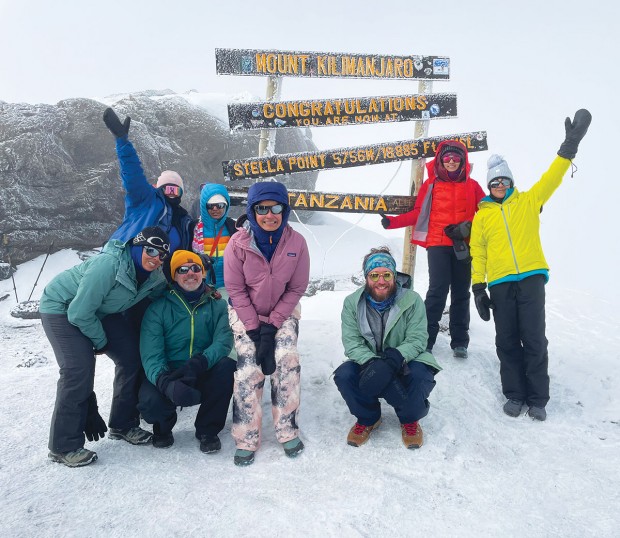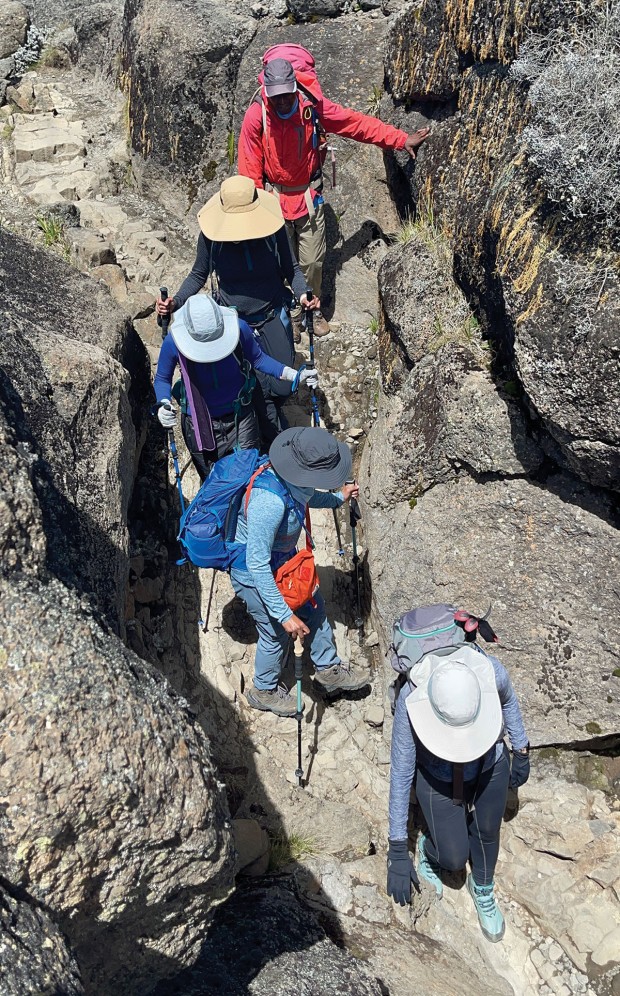Peak Pursuits
The women who tackled Mount Kilimanjaro

AT THE SUMMIT Friends (pictured, from left) Ritu Patel, Savitha Bonthala, Lee Lerner, Radha Korupolu, Pramoda Koduru, Aaron Bowers, Veena Sathyakumar Gautham, and Sweeya Ramireddy celebrate after making it to the summit of Mount Kilimanjaro, standing at 18,885 feet. The group completed the climb last December.
When a team of like-minded women band together, anything is possible – even summiting one of the world’s tallest mountains.
After taking a trip to the Himalayas with her daughter and hiking through many national parks during the pandemic, physician and clinical researcher Radha Korupolu fell in love with hiking.
“Every time we’d go to a national park, I'd find the most challenging hike to do,” Radha said. “It really motivated me and a love for mountains.”
Then she began setting her sights higher – literally.
While talking to family friends, Radha became interested in climbing Mount Kilimanjaro – the tallest mountain in Africa and the tallest freestanding mountain in the world at over 19,300 feet.
It turned out that many of Radha’s friends had also fallen in love with hiking and had been eyeing Mount Kilimanjaro, such as Bellaire resident and radiologist Veena Sathyakumar Gautam, who started looking into more mountains after hiking the half-dome in Yosemite National Park with her husband in 2018.
“That’s when I started reading up about Kilimanjaro,” she shared. “But you know, it requires a team, so it was just a dream for so long.”
In early 2023, however, this dream quickly materialized into a team and a plan: to hike Mount Kilimanjaro during the last week of December 2023.
Radha brought in her close friend from Oklahoma, gastroenterologist Pramoda Koduru, whom she frequently runs races with. The other five women, including Veena, were Radha’s friends from the Houston Women Physicians Wellness Group, a network of Houston-area, South Asian female physicians.
Some members of the wellness group, including internist and Memorial resident Sweeya Ramireddy, had run 10Ks and half-marathons – occasionally with other group members. Climbing one of the world’s tallest mountains, however, was a new goal, and it would require a whole lot of training.
Fortunately, this newly-formed group of women was not only committed to their own preparation, but also to each other’s. The WhatsApp group that formed quickly became an encouraging space, where members shared everything from links to proper hiking gear to advice columns by those who’d already tackled Kilimanjaro. The group chat was also where the ‘Kili Crew’ – as they often playfully called themselves – planned their workouts.
“It was a lot of ‘Okay, what should we do and how are we going to do it?’” said Veena. “You're going to be climbing, so let's plan on doing half an hour of stair master then build it up to one hour. Next, let’s plan on doing five miles, then ten miles and then, as we get close to the hike, let’s do 15-mile walks.”
However, the women knew that a step machine could only partially replicate Kilimanjaro, so they hiked two real mountains before December. The first was Colorado’s Pikes Peak, a 14,000-foot beauty some of the women scaled in June. The second was Mount Elbert, Colorado’s tallest summit, which they braced in August.
The women remember these two climbs as grounding experiences, instilling in them just how difficult December’s would be. In June, only two women successfully summited due to poor weather conditions. In August, the women learned that their entire approach to climbing had to be revisited.
“We tried to walk fast, and that was not the right thing for us to do,” Sweeya said. “Our bodies were not acclimatized to that altitude.”
The women scaled the summer summits with various levels of difficulty – for some, it was a gentle nudge to train more, for others it was a wake-up call. Still, no one surrendered. Instead, they turned inward.
“We said to each other, ‘We can always come down. It's not like there is a prize or something’,” said Radha. “So nobody gave up.”
On Christmas Day, the seven women, alongside Shad Aaron Bowers and Lee Lerner, two male friends of Pramoda, landed in Tanzania. The next day, the nine of them began their ascent.
They followed the Lemosho Route, one of the six main routes to reach the summit. The route takes roughly seven days to complete – five days for ascent and two for descent – and offers a less crowded, more scenic path up the mountain. While the overall summit success rate for Mount Kilimanjaro hovers around 70%, the Lemosho Route boasts a higher success rate, closer to 90%.
As the women ascended, they passed through five different climate zones, including rainforest, desert, and alpine. “You have different flora and fauna, corresponding to the climate changes as well,” said physical medicine and rehabilitation doctor Savitha Bonthala. “It’s just so beautiful. Mother Nature is so beautiful.”

ROCKY TERRAIN The hike brought the group through a number of different terrains, including forests, deserts, and rocky landscapes like this one.
The women were accompanied by a crew of four guides – most had summited Mount Kilimanjaro over 300 times, according to Savitha – and dozens of chefs and porters, who were hired to carry gear during the expedition and assist with other tasks like pitching tents. This crew of over 40 would prove indispensable on the women’s journey, offering comfort and energy. At the end of each day, as the women headed up to camp, they were greeted by a chorus of porters joyfully singing in Swahili, a ‘congratulations’ for having completed the day’s hike.
The first two days of the ascent were relatively flat (only a total elevation gain of 1,000 feet) and were designed to get the women acclimated to the height, especially given the hike begins at an elevation of over 11,000 feet. Alongside acclimation, the women enjoyed their first breathtaking views of the African savannah and the Shira volcano, one of the three dormant volcanic cones that make up Mount Kilimanjaro.
Day three of the ascent, on the other hand, is frequently considered the most strenuous because of the large elevation change. The women climbed from roughly 12,000 feet to over 15,000, an elevation gain designed to provoke a little altitude sickness and get you to slow down, according to Pramoda, who experienced mild nausea and headaches.
She wasn’t alone. Many of the women experienced symptoms of altitude sickness, including dizziness and difficulty breathing. What stood out to them, though, were not the symptoms, but how the other women in the group supported each other through them.
Deepthi Bollineni, an internist, suffered from nausea and headaches so severe she considered turning around. However, while resting at the campsite, eating dinner – usually a lightly-seasoned combination of rice or noodles with vegetables – her tentmate Veena encouraged her to take time to listen to her body. This gave her the strength to keep pushing forward.
“Nobody felt shy to show their vulnerable side, because it was just you and them. There was no family. They felt like family at that time,” said Deepthi. “And everyone was ready to offer what they had, whether it be as simple as Tylenol or a sanitary pad.”
For Radha, the women’s shared professions played a role in how they treated one another. “A physician's background definitely helps,” she said. “We all knew we would be keeping an eye on each other.”
Radha, who was awarded a grant from the National Institutes of Health to study mindfulness meditation training, brought her expertise to her friends on the mountain.
“She would help me meditate while we were resting so I wasn’t too anxious. It helped a lot to be with her,” said Pramoda.
Similar breathwork helped Veena who, during training, performed Pranayama, an ancient breath technique originating from Indian yogic practices, for thirty minutes daily.
“I think it really helped me on the mountain, especially after 15,000 feet,” she said. “It calms your nerves and helps with stress.”
While hiking to slow, classical Bollywood songs, the seven women reached Barafu Camp on day four, the last stop before their final trek up to the summit. This trek, however, was different from the previous four days – it started at midnight.
“We are geared up, we’ve eaten food, we’re fueled and ready to go and we just started climbing. We summited at around 8:40 in the morning,” said Savitha. “It was definitely the hardest thing I've ever done physically and mentally.”
While timing was crucial on each day of the expedition – too fast and you tire yourself out, too slow and you leave yourself vulnerable to the elements – summit timing was particularly regimented, hence the midnight start time. Hikers couldn’t camp near the top; they had to summit and start their descent all in one day. So, to keep the hikers on pace, guides implemented a 50-minute hike, 10-minute rest rhythm. Despite this additional pressure, they maintained their spirit, belting songs at 18,000 feet in the air and offering hikers ginger tea with extra glucose for energy.
When Deepthi reached the summit, she felt a spiritual connection.
“I felt connected to God, almost,” she shared. “You don’t see a speck of any life down there. You see just the sun and sky and that's what connects you.”
As she reached the summit, Savitha also felt a connection – to her mom who had passed away from cancer five years earlier.
“I heard her in the back of my mind just being like ‘Nana, you can do this.’ And I heard that over and over and over again,” she shared. “I felt her presence so strongly.”
On Dec. 31st, the seven women all summited and felt a range of emotions, from pure accomplishment to invincibility, from immense gratitude to relief. Some felt readier than ever to face the New Year; others had forgotten entirely that Jan. 1 was the next day.
These emotions, as one might imagine, didn't just fade once the women returned to base camp, or even back home to Houston.
For some, this expedition created tectonic shifts in how they view themselves. “It made me discover a strength in me that I didn't know I had,” said internal medicine physician Ritu Patel.
“It’s incredible how your body can do things you never imagined it could do,” said Pramoda.
Like Ritu and Pramoda, other women discovered a strength within themselves – even women who weren’t on the expedition.
“It's cool to see other women when the light bulb goes off in their head. They're like, ‘Really? I can do this too?’ And I'm like, ‘Absolutely you can,’” said Savitha.
Radha felt this with her own daughter. “Our children look at you, and they really feel like ‘Okay, if my mom could do this, I could do this,’” she said.
In this way, the energy and spirit of Mount Kilimanjaro had an infectious and addictive quality. On the hike down, as the women trudged in relief through familiar forests, they got to planning the next trip. On the shortlist are Mount Aconcagua in Argentina, Mount Kailash in Tibet, and the “Rim-to-Rim” hike of the Grand Canyon. In the meantime, Sweeya has signed her family up for the MS150 bike race, and a couple of the women are running 25Ks and 50Ks. New women are also joining the crew.
To many of the women, the friendships that emerged between each other and the bonds forged with the guides, chefs, and porters became the true peak of their quest to the summit of Mount Kilimanjaro.
“I think it’s so beautiful how each of us came together to help each other throughout this trip,” said Savitha. “You just can’t do great things like this by yourself.”
Want more buzz like this? Sign up for our Morning Buzz emails.
To leave a comment, please log in or create an account with The Buzz Magazines, Disqus, Facebook, or Twitter. Or you may post as a guest.


